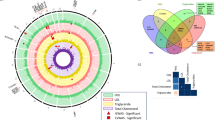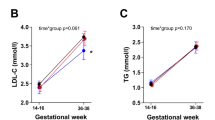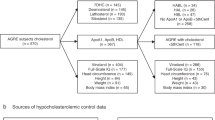Abstract
Cholesteryl ester transfer protein (CETP) is thought to regulate plasma HDL. Patients with CETP deficiency caused by mutation of the CETP gene [D442G; a missense mutation (Asp442→Gly)] have been reported to show high plasma HDL levels. However, there are no data available on children with D442G. To determine the effects of plasma CETP and CETP gene mutation (D442G) on lipids and lipoproteins in children, we screened children by PCR and restriction fragment length polymorphism analysis of the CETP gene. Plasma lipids, apolipoproteins, and CETP mass levels were also determined. In the current study, 22 children with D442G were found (21 heterozygotes and a homozygote). A homozygous child showed high plasma HDL level and very low plasma CETP mass. In heterozygous children, plasma concentrations of HDL cholesterol, apo A-I and apo A-II were not increased, whereas plasma CETP mass was significantly decreased. Plasma CETP mass in heterozygous children was correlated with plasma concentrations of total cholesterol, LDL cholesterol, and apo B. Plasma CETP mass in children without D442G was not correlated with the plasma concentration of any lipid or apolipoprotein. All of these data suggest that the D442G mutation, by itself, might not affect HDL metabolism in children. The CETP mass required for efficient HDL-cholesteryl ester clearance in children may be less than that in older subjects.
Similar content being viewed by others
Log in or create a free account to read this content
Gain free access to this article, as well as selected content from this journal and more on nature.com
or
Abbreviations
- CE:
-
cholesterol ester
- CETP:
-
cholesteryl ester transfer protein
- HDL-C:
-
HDL-cholesterol
- LCAT:
-
lecithin-cholesterol acyltransferase
- RFLP:
-
restriction fragment length polymorphism
- TC:
-
total cholesterol
- TG:
-
triglyceride
References
Reichel D, Miller NE 1985 Pathophysiology of reverse cholesterol transport, insights from inherited disorders of lipoprotein metabolism. Arteriosclerosis 9: 785–797
Tall AR 1990 Plasma high density lipoproteins: metabolism and relationship to atherogenesis. J Clin Invest 86: 379–384
Eisenberg S, Oschry Y, Zimmerman J 1984 Intravascular metabolism of the cholesteryl ester moiety of rat plasma lipoproteins. J Lipid Res 25: 121–128
Glass CK, Pittman RC, Weinstein DB, Steinberg D 1983 Dissociation of tissue uptake of cholesteryl ester from that of apolipoprotein A-I of rat plasma high density lipoprotein: selective delivery of cholesterol to liver, adrenal and gonad. Proc Natl Acad Sci USA 80: 5435–5439
Eisenberg S 1984 High density lipoprotein metabolism. J Lipid Res 25: 1017–1058
Cheung MC, Wolf AC, Lum KD, Tollefson JH, Albers JJ 1986 Distribution and localization of lecithin:cholesterol acyltransferase and cholesteryl ester transfer activity in A-I-containing lipoproteins. J Lipid Res 27: 1135–1144
Marcel YL, McPherson R, Hogue M, Czarnecka H, Zawadzki Z, Weech PK, Whitlock ME, Tall AR, Milne RW 1990 Distribution and concentration of cholesteryl ester transfer protein in plasma of normolipidemic subjects. J Clin Invest 85: 10–17
Ohta T, Hattori S, Nakamura R, Horiuchi S, Frohlich J, Takata K, Ikeda Y, Saito Y, Matsuda I 1994 Characterization of subspecies of apolipoprotein A-I-containing lipoprotein in homozygotes for familial lecithin:cholesterol acyltransferase deficiency. Arterioscler Thromb 14: 1137–1145
Ohta T, Nakamura R, Takata K, Saito Y, Yamashita S, Horiuchi S, Matsuda I 1995 Structural and functional differences of subspecies of apoA-I-containing lipoprotein in patients with plasma cholesteryl ester transfer protein deficiency. J Lipid Res 36: 696–704
Drayna D, Lawn R 1987 Multiple RFLPs at the cholesteryl ester transfer protein (CETP) locus. Nucleic Acids Res 15: 4698
Zuliani G, Hobbs HH 1990 Eco NI polymorphism in the human cholesteryl ester transfer protein (CETP) gene. Nucleic Acids Res 18: 2834
Kuivenhoven JA, De Knijff P, Boer JMA, Smalheer HA, Botma GJ, Seidell JC, Kastelein JP, Pritchard PH 1997 Heterogeneity at the CETP gene locus. Influence on plasma CETP concentrations and HDL cholesterol levels. Arterioscler Thromb Vasc Biol 17: 560–568
Brown M, Inazu A, Hesler CB, Agellon LB, Mann C, Whitlock ME, Marcel YL, Milne RW, Koizumi J, Mabuchi H, Takeda R, Tall AR 1989 Molecular basis of lipid transfer protein deficiency in a family with increased high-density lipoproteins. Nature 342: 448–451
Takahashi K, Jiang XC, Sakai N, Yamashita S, Hirano K, Bujo H, Yamazaki H, Kusunoki J, Miura T, Kussie P, Matsuzawa Y, Saito Y, Tall A 1993 A missense mutation in the cholesteryl ester transfer protein gene with possible dominant effects on plasma high density lipoproteins. J Clin Invest 92: 2060–2064
Inazu A, Jiang XC, Haraki T, Yagi K, Kamon N, Koizumi J, Mabuchi H, Takeda R, Takata K, Moriyama Y, Doi M, Tall A 1994 Genetic cholesteryl ester transfer protein deficiency caused by two prevalent mutations as a major determinant of increased levels of high density lipoprotein cholesterol. J Clin Invest 94: 1872–1882
Freeman DJ, Griffin BA, Holmes AP, Lindsay GM, Gaffney D, Packard CJ, Shepherd J 1994 Regulation of plasma HDL cholesterol and subfraction distribution by genetic and environmental factors. Associations between the TaqI B RFLP in the CETP gene and smoking and obesity. Arterioscler Thromb 14: 336–344
Hannuksela ML, Liinamaa MJ, Kesaniemi YA, Savolainen MJ 1994 Relationship of polymorphism in the cholesteryl ester transfer protein gene to transfer protein activity and plasma lipoprotein levels in alcohol drinkers. Atherosclerosis 110: 35–44
Agellon LE, Quinet E, Gillet T, Drayna D, Brown M, Tall AR 1990 Organization of the human cholesteryl ester transfer protein gene. Biochemistry 29: 1372–1376
Burnstein M, Scholnick HR, Morfin R 1970 Rapid method for the isolation of lipoproteins from human serum by precipitation with polyanions. J Lipid Res 11: 583–595
Warnick GR, Nguyen T, Albers AA 1985 Comparison of improved precipitation methods for quantification of high density lipoprotein cholesterol. Clin Chem 31: 217–222
Goto Y, Akanuma Y, Harano Y, Hata Y, Itakura H 1986 Determination by SRID methods of normal values of serum apolipoprotein (A-I, A-II, B, C-II, C-III, and E) in normolipidemic healthy Japanese subjects. J Clin Biochem Nutr 1: 73–88
Kiyohara T, Kiriyama R, Zamma S, Inazu A, Koizumi J, Mabuchi H, Chichibu K 1998 Enzyme immunoassay for cholesteryl ester transfer protein in human serum. Clin Chim Acta 271: 109–118
Sakai N, Yamashita S, Hirano K, Menju M, Arai T, Kobayashi K, Ishigami M, Yoshida Y, Hoshino T, Nakajima T 1995 Frequency of exon 15 missense mutation (442D:G) in cholesteryl ester transfer protein gene in hyperalphalipoproteinemic Japanese subjects. Atherosclerosis 24: 139–145
Hegele RA, Connelly PW, Hanley AJG, Sun F, Harris SB, Zinman B 1997 Common genomic variation in the APOC3 promoter associated with variation in plasma lipoproteins. Arterioscler Thromb Vasc Biol 17: 2753–2758
Hegele RA, Connelly PW, Hanley AJG, Sun F, Harris SB, Zinman B 1997 Common genomic variants associated with variation in plasma lipoproteins in young aboriginal Canadians. Arterioscler Thromb Vasc Biol 17: 1060–1066
Hegele RA, Ban MR, Busch CP, Ramsewak S, Ramdath DD 1999 Lipoprotein-genotype associations in Trinidadian neonates. Clin Biochem 32: 429–437
Woollett LA, Spady DK 1997 Kinetic parameters for high density lipoprotein apolipoprotein AI and cholesteryl ester transport in the hamster. J Clin Invest 99: 1704–1713
Murao K, Terpstra V, Green SR, Kondratenko N, Steinberg D, Quehenberger O 1997 Characterization of CLA-1, a homologue of rodent scavenger receptor BI, as a receptor for high density lipoprotein and apoptotic thymocytes. J Biol Chem 272: 17551–17557
Collet X, Tall AR, Serajuddin H, Guendouzi K, Royer L, Oliveira H, Barbaras R, Jiang XC, Francone OL 1999 Remodeling of HDL by CETP in vivo and by CETP and hepatic lipase in vitro results in enhanced uptake of HDL CE by cells expressing scavenger receptor B-1. J Lipid Res 40: 1185–1193
Acknowledgements
The authors thank Drs. Toshinobu Matsuura and Toshiya Tamura for their excellent technical advice, and Dr. Ken Matuyama (Fussa Hospital, Tokyo) for referring the child who was homozygous for D442G.
Author information
Authors and Affiliations
Corresponding author
Additional information
Supported by Health Sciences Research Grants (Research on Specific Diseases) from the Ministry of Health and Welfare and by Grant-in-aid No13470166 for Scientific Research (B) from The Ministry of Education, Science, Sports and Culture.
Rights and permissions
About this article
Cite this article
Arashiro, R., Katsuren, K., Maung, K. et al. Effect of a Common Mutation (D442G) of the Cholesteryl Ester Transfer Protein Gene on Lipids and Lipoproteins in Children. Pediatr Res 50, 455–459 (2001). https://doi.org/10.1203/00006450-200110000-00006
Received:
Accepted:
Issue date:
DOI: https://doi.org/10.1203/00006450-200110000-00006
This article is cited by
-
Association of CETP TaqI and APOE polymorphisms with type II diabetes mellitus in North Indians: a case control study
BMC Endocrine Disorders (2005)



